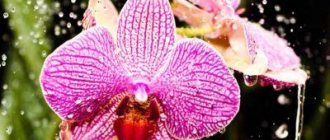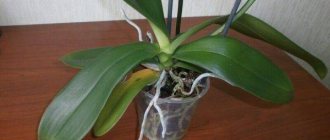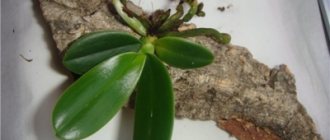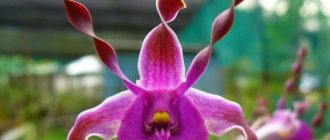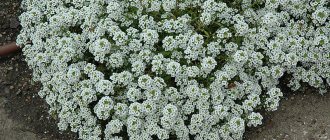Orchids should only be watered with soft water as the soil dries. During the active growing season, watering should be plentiful, and during the dormant period - moderate. It also depends on the room temperature, humidity, pot size, type of soil, and the type of orchid itself.
Along with watering, you can simultaneously feed the plant with nutrients:
- So, you can acidify the substrate with coffee or tea.
- Quite a lot of potassium is contained in onion peels. It needs to be crushed, boiled, steeped well and cooled. Water, diluted with water.
- They also use strained water after boiling potatoes; it contains potassium.
- You can feed with infused tree bark, but with a very weak solution.
- Many people use water from washed meat with blood and diluted manure for rare waterings, but it is still better not to do this, since there is a high risk of infecting the orchid with dangerous microorganisms.
You cannot water flowers with running tap water, as most often it is hard and contains many different harmful impurities.
How to feed the plant so that it blooms blue?
How can you treat an orchid to make it blue? Need to remember! There are no blue orchids! If one is sold in a store, then it is most likely white, simply painted with a chemical dye that will wash off over time.
For the first time, blue phalaenopsis was presented at an exhibition in the USA in 2011.
Then, a few months later in Holland, the famous nursery "Geest Orchideeën" presented to the public Phalaenopsis Royal Blue, colored using a patented technology.
This dye is natural and does not harm the plant. The secret of this technology is not disclosed. But many sellers, wanting to make good money and not caring about the health of the orchid, try to paint it the desired color without any technology. Most often this is simply an injection of ink or blue into the stem or root of a plant. After purchasing the orchid, it may simply die.
Japanese breeders have bred the only truly blue species of orchid by introducing the blue-eyed gene, but, unfortunately, it is not commercially available.
If you still really want to try “coloring”, it is better to use food coloring. Dissolve the paint in water for irrigation. The richer the color of the water, the brighter the color of the plant.
The procedure is simple, but not very effective and not durable.
If you stop watering the dye, the orchid will return to its original color. Flower growers recommend using water in which aluminum alum was soaked for safe coloring. The injection is more effective, but the damage to the plant is enormous. Most likely it will get sick and require constant care.
You need to think carefully about whether it is worth subjecting the orchid to such tests for the sake of temporarily changing the color of the orchid.
What kind of water should I use?
To water orchids, use soft, settled tap water, as well as boiled, rain, distilled water, and melted snow.
Rainwater and melted snow collected in the city will not benefit plants
due to the content of large amounts of gases and dust. Country snow and rainwater are stored in a cold place.
If there is no such water, you can boil tap water to make it softer and remove bacteria. The water filtration method is also suitable. Oxalic acid helps make water softer. You can remove high acidity with a few drops of lemon juice.
Distilled water is considered dead, it does not contain salts, so it is diluted with tap water: if the water is very hard, then take 2 parts distilled for one part of tap water, with medium hardness - one to one.
It is recommended to enrich any water with oxygen
, pouring it before watering from one dish to another.
How to save a rootless orchid using foliar feeding?
A few days later, still not knowing how to save an orchid without roots, and whether it was possible in principle, I began to spray it with “Doctor Foley Orchid” foliar fertilizer, and the cutting itself (the place where I was looking forward to the appearance of new roots) was simply sprayed with regular water from a spray bottle. And this lasted for about six months... Yes, yes, don’t think that in a week there will be wild flowering on your windowsill and the orchid will feel great. The orchid's roots have rotted, it is not as easy as it seems, but it does not give up and clings to life with its last leaves.
Can I use supplements?
Hydrogen peroxide
In small quantities, hydrogen peroxide accelerates the flowering of the orchid and its growth, gets rid of bacteria and pests, saturates the soil with oxygen, prevents the roots from rotting, and strengthens them.
More often, peroxide is used for disinfection and as fertilizer during illness.
, various damage to the plant. First, dry leaves and rotten flowers are removed from the orchid, and the soil is loosened. Then pour in a solution of hydrogen peroxide (30 ml per full glass of water).
Potassium permangantsovka
Manganese is involved in plant photosynthesis, and its deficiency (in alkaline soils) or excess (in acidic soils) adversely affects the well-being of the orchid, and chlorosis begins. But if you use the right soil (pH 5.5 – 6.5) this shouldn’t happen.
At home, a weak solution of potassium permanganate is used to disinfect orchids and as a fertilizer.
To do this, pour warm water into a glass container and drop several particles of manganese into it using a toothpick. Stir until they are completely dissolved so as not to burn the plant. Then mix the solution with settled water to the desired concentration.
Yeast
Yeast is a good feed for orchids and affects their growth
, help cope with diseases and some pests.
The solution is prepared at the rate of 1 gram of dry yeast per liter of water and left for one day.
The solution can be used to water or spray the orchids.
It is also advised to add a teaspoon of sugar or a few drops of valerian for a stronger effect of feeding.
Cytokinin paste
Cytokinin paste is, first of all, phytohormones that promote the growth of shoots and buds. It is applied with a needle to the bud and after about ten days a shoot appears.
The paste also helps to “raise” a dying orchid.
But it needs to be used in very small quantities.
Ammonia
Ammonia is used for orchids as a fertilizer and as protection against certain pests (ticks, midges), but you must be very careful with it so as not to burn the roots or poison the plant. Therefore, the solution should be minimally concentrated (preferably 10%).
It must be remembered that all these substances are beneficial only in small doses. Concentrated solutions can harm the orchid even more and even lead to death.
Fitolavin
Fitolavin is a systemic antibiotic and treats plants mainly from rot. This is a fairly safe and effective remedy both for the prevention of diseases and in the early stages of flower disease.
For orchids, phytolavine is often used for vascular wilting. The solution is prepared quite simply: 2 ml of antibiotic per 1 liter of water. You only need to spray with a freshly prepared solution.
Release form
Ammonia for orchids: application, reviews.
The name on the label “Ammonia” or “Ammonia solution” is the name of one substance. You can buy ammonia at any pharmacy, where it is sold in dark glass bottles. The most common containers are 30 ml, 40 ml, 50 ml.
Printing design depends on the manufacturer. Sold in pharmacies without a prescription. But for safe use, you must follow certain rules for working with the drug.
What are the results of improper watering?
Improper watering can lead to the death of the orchid. Although this plant is moisture-loving, it is still better to underwater than overwater. Otherwise, the roots will simply rot. After all, in nature, orchids grow on stones and tree branches.
Do not allow water to stagnate in the tray and in the orchid pot. This will lead to rotting of the roots and death of the plant. When there is an excess of moisture, swelling appears on the leaves
, which cannot be treated, they only need to be removed.
We must not forget that an orchid is a capricious plant, and proper watering is one of the important conditions for its health. If you follow simple rules, the orchid will delight you with its flowering for a long time.
Precautionary measures
We must not forget that ammonia is a strong poison
. Inhalation of its vapors in large quantities can cause respiratory arrest and heart rhythm disturbances. Such poisonings will subsequently require long-term treatment.
If a concentrated solution of ammonia comes into contact with the skin, it will cause a chemical burn.
In both cases, you should not self-medicate, but should contact a medical facility.
To avoid such consequences, when working with ammonia you need to take the following precautions:
- use a respirator and gloves;
- breed outdoors or in ventilated areas;
- do not mix with any other active substances except iodine;
- do not carry out processing in hot, sunny weather;
- Do not use the drug for people suffering from vegetative-vascular dystonia.
How to fix errors?
If overwatering does occur, the leaves become wrinkled, and the flowers or buds fall off, the orchid needs to be replanted. Under no circumstances should you dry a flooded orchid near heating devices.
or other heat sources.
- You need to remove the flower from the pot without damaging the roots, clean the soil from them and soak in water for 15 minutes.
- Then let it dry and examine each root.
- Remove all that are soaked or infected with fungus with pruning shears, and treat the cut areas with charcoal.
- Disinfect the new pot and replant without compacting the soil.
If almost all the roots are dead, then you cannot replant immediately. The orchid should be placed in a plastic jar with water so that its remaining roots almost touch the water. Maintain the water at this level and spray the plant. When the roots reach at least 5 cm, you can replant (?).
Practice shows that one of the main reasons for the death of orchids is improper watering.
Therefore, in order to avoid mistakes, especially for novice flower growers, you must first study how an orchid grows in nature, how it feeds, and, based on this knowledge, try to recreate its natural conditions as much as possible.
Moisture in the air: the key to success in caring for an orchid at home
Increased air humidity is extremely important for the successful cultivation of tropical plants. And if in the summer it is quite possible to achieve the desired 60–70%, then in the winter the gardener will have to try.
How to properly care for an orchid when heating devices are running, mercilessly drying the air in the room? To maintain such air humidity, electric humidifiers and household products are used.
The container in which the flowers are grown can be placed on damp moss placed in a shallow tray. If you don’t have sphagnum moss on hand that retains moisture for a long time, expanded clay is used in the same way. The plants feel best in a florarium or indoor greenhouse, separated from the rest of the room by plastic or glass.
When a florist uses foliage spraying for care, this should be done regularly and carefully, trying not to get it on the flowers. It is extremely undesirable to allow a still wet orchid to cool, as this will lead to the development of fungus on the succulent leaves and aerial roots.
The flower should be irrigated in the first half of the day with water at room temperature, until the foliage is dry; the pot should be protected in every possible way from cold air and drafts.
Useful video
From the video you will learn to avoid rotting:
If you find an error, please select a piece of text and press Ctrl+Enter
.
Orchids grown at home most often belong to the group of epiphytes that can get by with a minimum of nutrients, so fertilizer for orchids should not be too nutritious so as not to burn the roots of the plant.
Adapted to live in trees and receive nutrition from rotting wood soaked in water, such plants consume significantly less minerals and trace elements than garden crops. But plants that are so unpretentious in terms of soil nutrition require a certain amount of fertilizing. As a rule, special fertilizers are used for orchids, although sometimes they also use ordinary ones, making the concentration 3 times less than indicated in the instructions.
If necessary, to feed the orchid at home, you can use the usual mineral fertilizers used by gardeners. But if the store sells a special fertilizer for orchids, it is better to take this particular fertilizer. It should be taken into account that at different periods of flower growth they require fertilizing with different ratios of minerals and vitamins. When choosing a fertilizer for an orchid, you need to read its composition and choose the one that suits the plant at a given time.
During the period of green mass growth, the orchid is fed with fertilizer with a high nitrogen content. With the beginning of flowering, the type of fertilizer changes to one containing an increased amount of phosphorus. For the formation of buds, in addition to phosphorus, potassium is also required. Phosphorus is supplied during the process to produce beautiful and vibrant flowers.
During the growth period of a young orchid, the fertilizer should also contain an increased amount of phosphorus. The criteria by which they determine whether an orchid can already be fed or whether it is still in a state of hibernation look at the presence of a new leaf emerging from the growth point. If the leaf begins to grow, the orchid can be fed with a composition containing nitrogen.
Root feeding for orchids is applied to completely healthy plants. Foliar feeding is used during root growth, in case of root damage and diseases. You need to spray orchids with nutrients either early in the morning so that the liquid has time to dry.
In the absence of the opportunity to buy specialized fertilizers or because of the belief that natural organics are better, some orchid growers use “folk remedies” to fertilize orchids growing by feeding the plants with tea leaves, horse and cow manure, bird droppings, potato broth and other organics, theoretically replenishing the lack of nutrients. In fact, you can never say exactly what ratio of substances is in such fertilizers.
Organic substances in such fertilizers are in the form of complex organic compounds that can harm the orchid. In addition, all types of droppings are nitrogenous fertilizers that should not be used during flowering plants. The best fertilizer for orchids is the one that contains nutrients in the most accessible form for the orchid.
Fertilizer rules
When feeding orchids, you must follow certain rules. An incorrectly carried out fertilization procedure is extremely painful for plants of this family. It is better for an orchid not to provide enough nutrients than to overdo it with them. When doing this, you need to know how to properly fertilize, how to fertilize orchids and when you can’t add fertilizer to.
- You cannot feed the orchid immediately after transplantation. She must first adapt to new conditions.
- The diseased plant is also not fertilized.
- If there is any doubt about the concentration of the solution, it is better to further dilute the fertilizer, since in case of an overdose of fertilizing, the plant may get sick.
- Foliar feeding is not applied in the morning so that the rising sun does not burn the tender leaves.
- You cannot apply fertilizer to a dry substrate; first you need to thoroughly wet the soil in which the flower grows.
- You cannot feed a plant that has just been brought from the store. At home, orchids are fertilized only after flowering, which must have passed from the moment of purchase.
- Dry fertilizers should not be used. Due to the specifics, which are pieces of bark in which the flower grows, the dry matter will not be distributed evenly throughout the entire container even with very abundant watering.
General principle: orchids do not fertilize during dormancy. Typically, plants are dormant in winter; also, in the heat of summer, the growth of orchids also slows down.
When choosing fertilizers, you need to pay attention to the formula of the main ingredients of the fertilizer indicated on the label. Feeding orchids during flowering is carried out with fertilizer with the formula NPK = 4-6-6, that is, the proportion of the main components: nitrogen 4 parts, phosphorus 6 parts, potassium 6 parts. This feeding stimulates the flowering of orchids. The composition of the fertilizer for leaf growth is NPK = 4-3-3.
Recipe for garlic extract
- 2 small cloves of garlic
- 1 liter of boiling water
Peel the garlic and pass through a garlic press. You can just chop it finely with a knife. Fill with water, cover with a tight lid and place in a dark place. In one hour
strain and can be watered.
Dosage
Benefits of garlic water with succinic acid
Orchids often refuse to bloom, despite excellent conditions and care. And flowers bought at a big discount begin to wither after some time.
And after winter, many orchids need rehabilitation. Succinic acid increases resistance to adverse conditions, strengthens leaf turgor and stimulates.
very well with root rotting
, lack of root system, after transplantation, various damage to leaves.
Succinic acid is sold in pharmacies for ridiculous amounts of money. Apply maximum 1-2 times a month, alternating with watering with clean water.
Required Ingredients
- 1 tablet of succinic acid
- 1 clove of garlic
- 500 ml boiling water
How to prepare an infusion
Dissolve an acid tablet in boiling water. Finely chop the garlic or crush it in a garlic press and add it to the acid solution. Stir, cover and wait about an hour. Immediately pour the strained solution over the orchids.
Important
: Garlic extract with succinic acid can be stored for no more than 3 days in the refrigerator.
Not advisable
apply during lush flowering of phalaenopsis and for absolutely healthy plants. It's medicinal.
Features of phalaenopsis fertilizer
Phalaenopsis, especially its cultivated hybrids, belongs to long-flowering orchids and has its own characteristics when choosing and giving fertilizing. Due to the six-month flowering period, it is believed that phalaenopsis does not have a dormant period. In fact, its need for nutrients decreases in winter and summer heat. This can be noticed by slower leaf growth.
How to fertilize orchids is determined by their condition. In case of green mass gain, phalaenopsis is offered nitrogen fertilizers. When the peduncle grows, potassium-phosphorus. Under no circumstances should fertilizers be used during the flowering period of phalaenopsis. Fertilizing will speed up the flowering of the plant.
Experienced orchid growers recommend a new complex fertilizer as a fertilizer for phalaenopsis orchids. Fertilizer can be applied both by root and foliar methods. The fertilizer contains nutrients in the form most convenient for absorption. The concentration of this fertilizer is very low and does not harm orchids. In addition, the product contains vitamins C, B, P, which strengthen the plant’s immunity. In the absence of this brand, when deciding what to feed the orchid, you need to take into account that other complex fertilizers need to be used in a concentration 10 times less than indicated in the instructions on the label.
Instructions for use
Watering
- The first session of watering
with a solution of ammonia is carried out after planting (transplantation), when the orchid has completely taken root. It can be identified by the growth of two or three new leaves. It is not worth applying nitrogen fertilizers earlier; the plant must adapt to new conditions and become stronger after stress. - With routine care,
root feeding replaces one of the waterings. During the period when orchids do not bloom, nitrogen fertilizer is applied at intervals of 15–20 days. - During flowering,
well-developed specimens are fertilized with foliar fertilizer, as well as to protect against orchid pests.
Brands of fertilizers suitable for orchids
Previous mineral fertilizers have been replaced by preparations containing substances in the most accessible form for absorption. One of these fertilizers is the Finnish brand Kemira. For orchids, one of the types of fertilizers used is this one. This form is suitable not only for orchids, but also for other indoor flowers and garden crops. How to fertilize an orchid with Kemira Lux fertilizer can be read in the instructions for the package.
- an important event. The beauty and health of the orchid depends on how moisturizing it is.
Not observing it or doing it incorrectly, novice gardeners are surprised at the drying out and death of their pet. Even if it is possible to take timely measures in this case, they will save her, but she will not gain color for a long time.
To water orchids (but as recommended and without fanaticism), it is recommended to use ammonia, hydrogen peroxide, cytokinin paste and yeast, but it is strictly forbidden to use a weak solution of potassium permanganate. Organic fertilizers are also contraindicated for the flower: manure and compost, since their use leads to damage to sensitive roots.
So that it blooms blue
Some gardeners water the orchid with colored water.
As a result, the pet acquires a blue tint on the leaves, roots and flowers. They act recklessly, causing her harm. Whether she survives or not depends on how strong he is. Why paint the buds blue using ink or blue for watering if such a procedure is harmful? A natural shade always looks more natural and richer.
Security measures
Before opening a bottle with a pungent odor, it is better to use a mask or disposable respirator. But even then, you should not inhale the vapors of the ammonia solution. They are not as harmless as some gardeners think.
When preparing and working, it is better to wear protective gardening glasses that fit tightly to your face. This measure is necessary to protect the eyes from accidental exposure to liquid or vapor.
To prevent liquid from getting on your hands, you need to use rubber or latex gloves.
Advice. The exact volume of liquid can be measured with a medical syringe. If it is not there, then adhere to the following rule:
- It is better to take a little less of the drug than to exceed the concentration. Excess ammonia in the solution can cause burns to the roots and leaves.
What kind of water should I use?
An orchid is a plant that in nature lives in conditions of heavy rain with a relatively small amount of salts. How to water an indoor flower? The best is rainwater, but when it gets into the ground it becomes enriched with salts. It is difficult to predict their concentration, since it depends on the region, type of soil, etc.
Reference.
Orchid roots are sensitive to cold water. If you pour water on her that is not at room temperature, she will become stressed.
It also threatens if you do not pay due attention to the quality of water. Tap water is a “storehouse” of unnecessary salts.
It is not suitable for watering orchids. To remove salts and improve its quality, there are special methods. Which?
It is not always and not everywhere possible to collect it in order to subsequently use it in watering orchids. When collecting it, make sure that it is clean. The collection is carried out outside the city, where there are practically no cars and where there are no traces of civilization. Having found the ideal place, they always keep it clean.
After collecting rainwater, choose the right place to store it. A dark, secluded and cold corner will do. Darkness and cold help prevent the growth of bacteria in it.
Advantages:
- Cheapness.
- The naturalness of rainwater.
Flaws:
- Difficulty finding a place to gather.
- Impossibility of organizing special storage conditions.
Boiled
By boiling water, flower growers achieve temporary removal of hardness from it. Salts turn into scale. If the water hardness in the region is normal, boiling is the ideal method.
Advantages:
Simplicity.
Flaws:
Ineffective if the region's tap water is too hard.
Distilled
If the grower has two or three orchids, you can buy distilled water at the flower shop. It is diluted with tap water, but taking into account the following nuances:
- Very hard water – 1 tsp tap + 2 tsp distilled.
- Medium hardness - 1 part each of tap water and distilled water.
Advantages:
Possibility of independent control over salt content.
Flaws:
High price for distilled water.
Filtered
On a note.
Stores sell flow filters and jugs. Both remove salts, making the liquid immediately after filtration suitable for irrigation.
Sometimes one-time filtration is not enough, since the water is hard.
Advantages:
- Simplicity.
- Low price of filters.
Flaws:
- Slow filtration speed.
- The need to periodically replace cartridges so as not to harm the flower.
Settled
This method is the least expensive and optimal. A day after pouring water into the bottle, it is ready for use.
The main thing is not to shake it, as there is always sediment at the bottom.
Is it possible to use solutions?
Not all solutions that gardeners use to ensure abundant flowering, leaf growth, etc. other plants, suitable for watering orchids. Which ones can and cannot be used?
Hydrogen peroxide is a stimulator of growth and death of pathogenic microorganisms. It is used for soil treatment and substrate disinfection. It saturates the roots and leaves with oxygen, resuscitating a flooded orchid whose roots have begun to rot. In order not to harm, but to help the plant, strictly observe the proportions when mixing peroxide with water.
- Pest control:
2 tbsp. l. 3% water peroxide per liter of water. The resulting solution is sprayed or watered on the orchid. - Resuscitation:
3 ml of peroxide per 1 liter of water. - Regular watering:
5-10 drops of water per liter of water.
Potassium permangantsovka
Do not water the orchid with a weak solution of potassium permanganate. Yes, it is effective when fighting mold in the soil and fungus, but not in the case of phalaenopsis orchids. Potassium permanganate causes their roots to burn.
Yeast
It also helps to revive the plant if the roots are almost all rotten. The main thing is to make the yeast solution for watering correctly and not add it more than once a month. Fertilizing is done as follows: one pack of dry yeast (10 g) and 3 tbsp are diluted in ten liters of warm water. l. granulated sugar. After stirring, the mixture is infused for two hours, and then the orchid is watered with it.
A new product in flower shops is cytokinin paste. The main active ingredient in it is the phytohormone cytokinin. It stimulates cell division. If desired, make the paste yourself, but at the same time observe all precautions, since it is prepared from dangerous substances. Keep it in a cool and dark place and make sure that children do not play with it. Special properties of cytokinin paste:
The paste consumption is small: 100 grams is enough to process not only home, but also garden flowers. The optimal time for fertilizing is the end of winter - the beginning of spring.
Cytokinin paste is a drug that should not be used at random
, without following the manufacturer’s recommendations and without applying nitrogen and complex fertilizers. Otherwise, there is a high risk of the orchid drying out and dying. It is not recommended to use the paste if the orchid is sick, pest-ridden, or under stress.
Ammonia
You can fertilize an orchid using ammonia, i.e. clear white liquid with a pungent odor. It is a source of nitrogen, i.e. the most important element for her. It is needed to establish the process of photosynthesis.
Reference.
If there is a lack of nitrogen in the substrate, the production of chlorophyll will be disrupted and chlorosis will develop. The leaves turn pale, turn yellow, and eventually die.
The orchid is watered with an ammonia solution at the root. Dilute 3 tbsp in five liters of water. spoons of ammonia. It is used for watering once every three weeks until alarming signs appear. Sometimes gardeners apply this fertilizer only in February-March once every 15-20 days in order to support the orchid during the period of active growth and before the formation of buds.
Fitolavin
Fitolavin is a systemic drug designed to protect plant crops from bacterial diseases.
It is recommended for those who grow fruit trees and vegetable seedlings, plants in a greenhouse, and open ground. It is not suitable for protecting orchids from bacterial diseases.
The effect of ammonia on plants and soil
Opinions about the appropriateness of use and benefits of the pharmaceutical product are mostly positive. Many amateur flower growers, vegetable growers and gardeners use ammonia when caring for plant crops of various types and genera.
The main benefit of the pharmaceutical product is associated with the high nitrogen content, which plants absorb only from the substrate. A deficiency of a useful substance leads to a decrease in the rate of photosynthesis and insufficient production of chlorophyll.
Important details:
Read also How to draw a wooden barrel with a pencil step by step
- The addition of a valuable component from a solution based on ammonia compensates for the lack of nitrogen, which has a positive effect on the condition of the green mass and the growing season. Seedlings show excellent results from fertilizing with a pharmaceutical product.
- The second type of impact is that the smell of ammonia repels pests. Ammonia is a biocide, thanks to which the plant receives protection from many insects and other types of parasitic creatures. Pests sense the unpleasant odor of ammonia even with a low concentration of the working solution for soil treatment, which makes it possible to repel insects without harming indoor flowers, fruits and vegetables.


